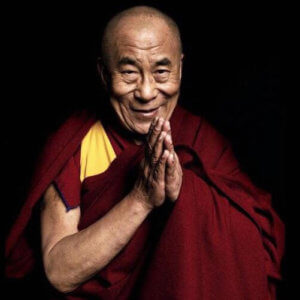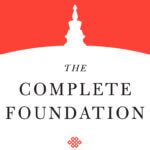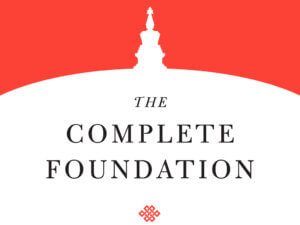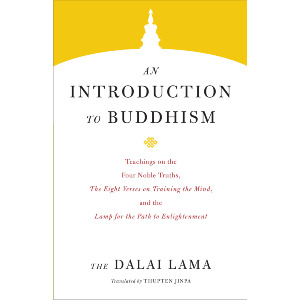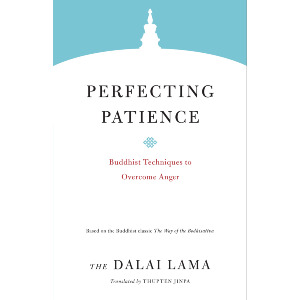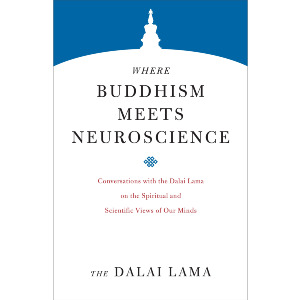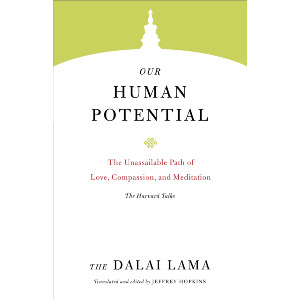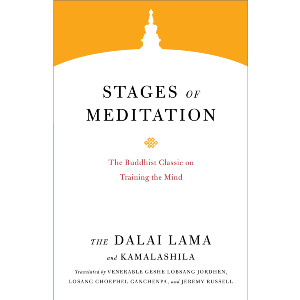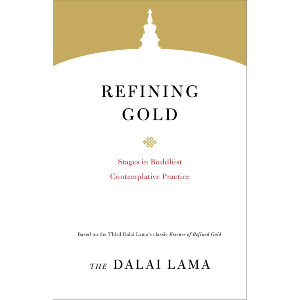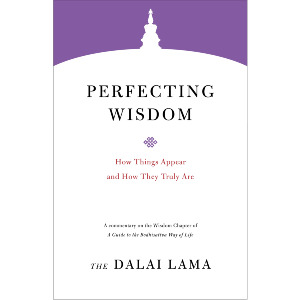One’s motivation at the beginning is very important, because whether or not one’s practice becomes successful and effective depends upon the initial motive and attitude. For the development of the right attitude, the practice of refuge and the generation of bodhicitta are vital. Through the practice of the two one should be able to bring about some discipline and transformation within one’s mind.
So, on a comfortable meditation seat you should adopt the right physical posture and then generate the appropriate motivation. After you are seated facing eastward (or imagining that you are facing eastward), reflect that you are very fortunate to have this opportunity to engage in the practice of dharma, and that you will make this session most worthwhile. Rejoice that you have this opportunity, and think that, at this juncture, when you have obtained most of the important conditions for making progress on the path, there is hope that you can embark on the right path and make some spiritual progress.
It is almost like being at a critical crossroad and taking a new turn in your journey, embarking on a path leading to the achievement of the omniscient state—not for your own sake alone, but rather for the benefit of all living beings.
Also reflect that you possess within yourself, as do all living beings, the potential or the seed of buddhahood, and also have access to the means by which this potential can be successfully activated. Think: I shall explore this potentiality to its fullest extent, and I shall make the most of the present opportunity. Furthermore, you should reflect upon the fact that you have been extremely fortunate to have received many teachings from the master and that you are equipped with the knowledge to undertake the practice properly.
You should understand that the whole purpose of listening to teachings, taking teachings, and studying them is to put them into practice, just as after having learned how to prepare a certain dish, you utilize that knowledge to make the dish and derive full nutritional benefit from it. What you know should be put into practice immediately; you can thus derive the benefit of having some transformation within your mind. Even though it might be a very minor effort, a very small practice just leaving imprints within your mind, still you must think that it is worthwhile to do. Otherwise, your knowledge of dharma will be quite fruitless, and like merely playing something on a tape.
At the initial stage it is important to have short sessions, as many of them as possible in a day. Generally speaking, the texts speak of four sessions, two in the morning and two in the afternoon, but you could make it into six. The length and the number of the sessions should be judged according to your own personal disposition. Your practice should be enduring, and you should undertake it with sustained effort. But because at the initial stage much depends upon your physical condition—the body’s influence on the mind is very powerful—you have to take the body’s condition into account. So it is very important to be careful. Some practitioners who put the body to a severe test in their practice of dharma may end up losing it, as such an act is very destructive.
Once you have made good progress on the spiritual path, you will gradually gain control over your body and mind through meditative stabilization. Particularly when you have gained control over the subtle energies, you will be able to employ your body for any length of time without there being any danger of imbalances being caused by your spiritual practices. This stage is quite difficult to attain; therefore at the initial stage it is very important to be cautious and very skillful.
I make this remark for the people who are undertaking the practice of dharma very seriously as solitary meditators in the mountains. For you, it is crucial right from the beginning to be skillful and cautious so that you can maintain a sustained effort. If you can undertake such a practice when you are young, you will be able to make great progress, whereas if you start when you are already too old, you may not be able to make much progress.
You can do the sessions at the initial stage for about half an hour or maybe an hour, depending upon your own conditions, and after that you can end the session and do other practices or take a rest.
For those of you who are not able to devote all your time to meditation, there is nevertheless the possibility of engaging in practice in a serious way. For example, the students at the monastic universities in South India can, with some effort, do meditations during the prayers. When you recite the prayers, you can mentally do the contemplation. The lifestyle and daily routine at these monasteries have been structured by the great masters of the past in a way that is most conducive to individual practice as well as to the flourishing of the dharma.
If you find that your mind is in a very fluctuating emotional state—displaying anger, hatred, attachment, and so forth—then you should first try to calm down that state of strong emotion. This should be done by first transforming it into a neutral state of mind, because there is no way that one can switch directly from a negative state of mind to a positive one. Therefore, you should first reduce the force of these emotions and fluctuations and try to bring about some sort of calmness, using any means—such as taking a stroll or concentrating on the inhalation and exhalation of the breath—that will enable you to forget what you are immediately feeling. This will help you to reduce the force of strong emotion, thereby giving you the calmness necessary for the practice of dharma. Like a white piece of cloth which could be dyed any color that you desire, such a neutral state of mind could then be transformed into a virtuous state of mind.
You could also engage in the preliminary practices of performing 100,000 prostrations, recitations of the Vajrasattva mantra, and so forth. When you undertake these practices, you should do them properly, not being only concerned about the number. Many great masters of the past of all traditions have emphasized the importance of these preliminary practices—they will enable you to have a very firm start. If through them you can acquire a fertile mind, then when the seed of meditation is planted, it will readily bear the fruits of realizations.
Having successfully neutralized the emotional fluctuations within your mind and having restored a reasonable degree of calmness, you should then engage in the practice of taking refuge and generating the altruistic aspiration to attain full enlightenment. Taking refuge in the Three Jewels is the factor that distinguishes one’s practice from that of an erroneous path, and the generation of the altruistic mind makes it superior to the paths aiming at individual liberation.
Think: I shall explore this potentiality to its fullest extent, and I shall make the most of the present opportunity.
Taking the Preliminary Refuge
First of all, visualize the objects of refuge. This should be done by visualizing, above and in front of you in space, your own spiritual master in the aspect of Buddha Shakyamuni. His hands are in the normal position, the left arm in a meditative posture, holding a bowl full of nectar symbolizing victory over death and all forms of obstruction, the right in the gesture of touching the ground, signifying his victory over the divine youth mara.
Visualizing one’s own root guru as the object of refuge allows one swiftly to obtain inspiration; visualizing him in the aspect of Buddha Shakyamuni makes such an inspiration more extensive and vast. Thus you should visualize the spiritual teacher in the form of Buddha Shakyamuni, possessing all the major and minor noble marks of the Buddha such as the crown protrusion, in the nature of light, crystal clear, very radiant. This clarity symbolizes the union of the illusory body and Clear Light.
The guru is seated in the vajrasana cross-legged position. This position of the legs symbolizes the Buddha’s having realized the completely enlightened state through the four vajrasanas (inseparable crossings): the asanas of the legs, the channels, the energy winds, and the vital drops. This position further symbolizes invulnerability to any form of obstacle.
Your spiritual master in the form of Buddha Shakyamuni is seated in the center of a very vast and expansive throne, surrounded by four small thrones, on a variegated lotus and sun and moon disks. In front of him, on a small throne, is your own root guru who is kind to you in all three ways, the guru to whom you feel most close. You should visualize him in his normal appearance, excepting any physical defects he may have. Then visualize him being surrounded by all the gurus from whom you have taken teachings directly.
I found that some commentaries state that even though your root guru may be a lay person, when you visualize him in the merit field you should see him in the aspect of an ordained bhikshu.
On Shakyamuni’s left imagine Manjushri surrounded by the lineage masters of the Profound View, on his right Maitreya surrounded by the lineage masters of the Vast Practice, at the rear Vajradhara surrounded by the lineage masters of the Experiential Practice. These lineage masters form what is known as the “five groups of lamas.”
All of them are surrounded by the meditational deities of the four classes of tantra, bodhisattvas, arhats, heroes, heroines, and protectors. There are different ways of visualizing the heroes and heroines: heroes on the right and heroines on the left, or, in some traditions, heroes and heroines in union.
For us, what is of prime importance at the beginning is to develop a deep conviction in the Three Jewels in general, and in particular, the possibility of achieving dharma, Buddha, and sangha within ourselves. If we do not develop this conviction, we will not have a very firm and stable foundation. Without such a conviction, if we complement our practice with various visualizations of dharmapalas, heroes, heroines and so forth, instead of benefiting us, this diversity might actually harm and confuse.
For this reason it is most important to have a very clear understanding of the Three Jewels. This in turn requires an understanding of the dharma, which requires an understanding of what is called the truth of cessation, which requires a good understanding of profound emptiness.
So, first of all you should have the deep conviction that cessation of the sufferings and the delusions is possible, and also that it is possible within your mind. True cessation is a state where you have destroyed the delusions at their root so that there remains no potential for their re-emergence. Such a cessation can be realized only through the true paths that penetrate into the nature of reality.
When you develop this conviction, you will also be able to develop faith in a being who has really mastered cessation, who is the Buddha—a person who has fully accomplished the realization of the dharma. If you contemplate along such lines, you will be able to develop a very deep faith and conviction in Buddha Shakyamuni and see him as an incomparable master.
What distinguishes Buddhist practitioners from others is the factor of taking refuge. But merely seeking a refuge out of the fear of suffering is not unique to Buddhists; non-Buddhists could also have such a motivation. The unique practice of refuge that Buddhists should have is that of taking refuge in the Buddha out of a deep conviction in his exceptional qualities and realizations. If you think in such terms you will be able to understand Lama Tsongkhapa’s profound praise of Buddha Shakyamuni: “Those who are far from his doctrine always reinforce the illusion of self-existence that they have within themselves, whereas those who follow his guidance will be able to free themselves from such confusions.”
The conviction that cessation of suffering is possible will furthermore enable you to develop deep faith and conviction in the sangha, the spiritual community that will provide you with companionship on your path. If you develop this proper understanding of the Three Jewels, you will have developed a good understanding of the general framework of the entire Buddhist path. Only then will you be able to understand the particular significance of various visualizations, such as those of meditational deities, heroes, heroines, protectors, bodhisattvas, arhats and so forth, because then you will see the importance of their differing appearances.
Just as Sakya Pandita said in his Domsum Rabye (The Divisions of the Three Vows), unless one develops a good understanding of the Three Jewels, one will not understand the significance of the protectors and so forth. I have a German friend who is quite familiar with the Buddha’s teachings; when she visited monasteries in the Himalayan regions, some people pointed out to her that protectors and meditational deities are superior to Buddha Shakyamuni. My friend told me that she didn’t find that assertion to be very convincing. She is right, because if you do not have a proper understanding of the Three Jewels, then when you see all these different images, you will have the notion that they are totally different from, and unrelated to, each other, as though they were inherently existent, thus giving you a misunderstanding of their relationships to each other.
Therefore, I think that if you base your knowledge of Buddhism on a proper understanding of the Three Jewels, which is a common foundation for Buddhist practice, then your understanding of the meditational deities will be good. Then you will also understand the importance of the different kayas, the various bodies of the Buddha, and the importance of the path that has the aspect of union of method and wisdom. Only at that point will you be able to understand the significance and importance of these meditational deities that are the physical manifestation of the union of method and wisdom. Without the proper understanding of the Three Jewels and the general framework of the Buddhist path, if you simply visualize a very impressive and wrathful-looking deity, your practice, instead of being beneficial, may turn out to be quite harmful and may increase anger and emotion.
If you find such complex visualizations quite difficult at the initial stage and disturbing to your main practice of taking refuge and generating the mind of enlightenment (bodhicitta), then a shorter version of visualizing the Three Jewels may be more suitable—that is, visualizing your spiritual master alone, but seeing him as the embodiment of the entire merit field. Visualize him in the aspect of Buddha Shakyamuni and perceive him as the embodiment of the Buddha, dharma, and sangha. This simpler practice is known as the Jewel Embodiment (Kuntu Norbu Lug). For some people, the visualization of many different figures in a merit field is more beneficial and effective, but for others the visualization of just a single figure alone, such as the Buddha Shakyamuni or your own spiritual master in the Buddha’s form, may prove more effective and powerful.
Whether to undertake a very extensive visualization or to use a short and condensed visualization is a matter that you yourself should decide on the basis of your own mental attitude and disposition. The point is, whatever is more beneficial and effective for you should be adopted, since the purpose of all this visualization is to bring about some effect and change and progress within your mind. So, if you can achieve these with a condensed form of visualization, that’s fine, and if you think you need a more elaborate version, choose that.
Visualizing one’s own root guru as the object of refuge allows one swiftly to obtain inspiration.
If you want to do the practice of taking refuge in a more elaborate way, then—just as you find described in the first chapter of Abhisamayalankara—begin by reflecting upon the ultimate nature of all phenomena that makes it possible for them to function on the conventional level. All these phenomena have dual aspects, the ultimate nature which is the empty nature, and then, on the conventional level, their individual appearances and various characteristics such as production, disintegration, and so forth. Reflect on these dual aspects, the Two Truths of phenomena, and then elaborate these Two Truths further and reflect upon the Four Noble Truths. Although all phenomena lack inherent existence, when they appear to us they appear as if they had an inherent nature and existed in and of themselves. It is ignorance that grasps at the belief in the true existence of phenomena and serves as the root cause of all subsequent delusions. Once we realize that ignorant mind states are deceptive and distorted, we will be able to see through their illusions and be able to free ourselves of ignorance, thus enabling us to achieve the state of cessation.
Generally speaking, when we talk of refuge we are referring to different types of refuge: outer, the practice of refuge that is common to the lesser vehicle; inner, the unique refuge of Mahayana; and secret, the unique refuge of tantra. This latter refers to the practice of going for refuge to the meditational deities, heroes, heroines, et al., which also has its own division into outer, inner, and secret refuges. We find that the practice of refuge is very important as well as vast, and that it should conform to the kind of practice we are undertaking.
Having visualized the objects of refuge, imagine in front of them the scriptures composed by great beings, in the aspects of texts and in their nature created of light. These scriptures should be imagined also as resounding with the sounds of the letters as though they were being read.
All the objects of the merit field should be seen as looking pleasantly at you. Different commentaries explain the reason for the merit fields gazing at us with pleasure as follows: Although our own states of mind are very weak and inferior, and therefore there are no grounds for the merit fields to be delighted with us, since we are now embarking on a path that will lead us to a spiritual transformation, we imagine that in order to encourage us in our initiative the merit fields gaze at us with delight. This explanation is according to the tradition of the late Kyabje Trijang Rinpoche. Another tradition maintains that the significance of this visualization is that these noble beings display such a gesture in order to give us more courage and determination. On your part, you should cultivate deep respect for and faith in the members of the merit field by reflecting on their great qualities and kindness.
After having visualized the merit fields, reflect upon the fact that you have experienced intense sufferings over infinite lifetimes, and that if you pursue your present state of mind and action, you will continue to torment yourself with sufferings in the cycle of existence. Therefore, right now determine that you shall engage in the practice that will bring about some change, and will undertake this practice of taking refuge in the Buddha, dharma, and sangha as well as in the guru.
With such reflections, repeat the refuge formula:
I go for refuge to the Guru.
I go for refuge to the Buddha.
I go for refuge to the Dharma.
I go for refuge to the Sangha.
While doing this recitation, visualize yourself surrounded by all the mother sentient beings in their human aspect. This is done because human beings possess the highest potential for making spiritual progress. Other masters explain that all these sentient beings, although visualized in the aspect of human beings, should be thought of in the nature of their individual forms of existence and actively undergoing the sufferings of their particular realms.
When you recite the refuge formula, imagine that you do so in unison with all these sentient beings around you. Imagine that all of you possess the basic factors of fear of the sufferings in this cycle of existence and the conviction that the three objects of refuge have the power and capacity to help free you from this fear. Whether or not your practice of refuge is successful depends upon whether or not you have the right attitude, these basic factors. So, equipped with these two factors—fear of cyclic existence and deep conviction in the three objects of refuge—if you repeat the refuge formula as much as possible, your practice of refuge will be successful. On the other hand, if you are not equipped with the two basic factors, even though you might repeat the refuge formula many times, you won’t make much progress.
You should also reflect upon the acute sufferings of all the sentient beings around you, the general sufferings of cyclic existence, and the specific sufferings of the individual states of existence. Sentient beings like yourself, human beings, although not actively undergoing the acute sufferings of hell realms and animal realms, are nevertheless in the process of aggregating conditions for such sufferings in the future because they are actively working for their own downfall. Therefore, it is only a matter of time until you actually experience such sufferings. By reflecting upon the sufferings of cyclic existence, you should develop fear of them; this should immediately be followed by a deep conviction that the Three Jewels have the power and capacity to relieve you from such sufferings.
Among the Three Jewels, the actual refuge is the dharma, because it is only by bringing about the realization of dharma within yourself that you will be able to free yourself and relieve yourself from the sufferings of cyclic existence. Therefore, dharma is the actual refuge, and the Buddha is the master who shows you the path leading to realization, and the sangha is the spiritual community that provides you with companionship on your path. Thus, these Three Jewels have the potential and power to relieve you from the cycle of existence, but you should not have the attitude that those who entrust themselves to them are automatically relieved without the need for practical initiative on their own parts.
So that your taking of refuge accords with your basic ideals as a practitioner of the bodhisattva path, you should complement your practice of refuge with the generation of a deep compassion toward all beings. You should think that not only yourself but all other sentient beings revolve in this cycle of existence fraught with misery and suffering; although they seek happiness and wish to avoid suffering, still they have to undergo this fate, against their wishes.
So, equipped with these three factors—the fear of cyclic existence, the conviction that the Three Jewels have the power to relieve you, and a genuine sense of compassion for the sufferings of all other sentient beings—then, as a physical expression of your sense of the unbearableness of the sufferings of cyclic existence for yourself and other sentient beings, you should recite the refuge formula. The recitation is an expression of what you feel inside, one that is spontaneous and natural. It is only when you have very strong anxiety and emotion that your cry of anguish comes out spontaneously and naturally.
It is important that the meaning of the verses should be integrated into your own mind. If you merely recite the verses with a distracted mind, you might accumulate certain virtues of reciting religious teachings, but you will not be able to derive much benefit.
You should do the repetition with the hands folded, taking refuge in the guru as many times as possible. When you do the repetition, visualize the five groups of gurus, focusing upon them especially and thinking that all the negativities that are committed in relation to these gurus, and particularly the Three Jewels, are being purified. To do this, visualize nectars of five colors descending from the bodies of these gurus; the nectars enter your body and purify your mind of all the negativities committed in relation to the Three Jewels and particularly your own spiritual root guru. You receive the inspiration of body, speech, and mind of all the gurus, particularly your own spiritual master. Then imagine that you are now placed under the kind care of the spiritual master. These three visualizations—purifying the negativities, receiving the inspirations from the objects of refuge, and finally being placed under the kind care of these refuges—are vital.
The three phases of visualization should be done when you take refuge in the Buddha, dharma, and sangha. Generally speaking, you should not have the notion that there is a separate guru from the Buddha. A qualified guru should be a buddha possessing all the great qualities of the Buddha. Therefore, there isn’t any being called guru apart from the Three Jewels, particularly in the context of Mahayana practice and especially that of the tantric path, because in all these practices all realizations depend upon receiving the right inspiration from the spiritual master. Particularly in the practice of tantra, one takes vows and pledges from the guru, seeing him as inseparable from the principal deity of a mandala. Therefore, receiving a transmission from a living person becomes an extremely important element in the practice of tantra. This point is demonstrated by the simple fact that although in the Perfection Vehicle practice the bodhicitta vow can be obtained from a representation of the refuge, such as a statue, tantric vows can be received only from a living person.
It is important that the meaning of the verses should be integrated into your own mind.
Although you do not have the opportunity and fortune to have direct access to Buddha Vajradhara himself, you do have access to the inspiration that comes from him in an uninterrupted lineage. Because it is the guru who transmits this uninterrupted lineage to you, he is the link between you and Vajradhara. Therefore, he is regarded as the only entrance through which you receive the inspirations of the Buddha. Because of the extremely vital role that the guru plays in your spiritual development, a specific refuge is taken in the guru.
Light rays emanate from the hearts of the spiritual masters of the five groups. Visualize these light rays in the form of straws of light that enter through the crown protrusions of yourself and all sentient beings. Through these flow streams of nectar; thus you purify the negativities that you have committed in relation to the Three Jewels and receive all their inspiration of body, speech, and mind. You should imagine, as a result, that you are placed under the kind care of the Three Jewels and particularly of the spiritual master. This practice of taking refuge should be followed by the generation of bodhicitta.
Preliminary Generation of Bodhicitta
The etymological meaning of the Tibetan term for bodhicitta, sem kye, is “to enhance one’s courage or mental attitude.” Therefore, bodhicitta is an altruistic state of mind that aspires to attain the completely enlightened state for the benefit of all other sentient beings.
In order to generate such a powerful altruistic mind, it is important to focus upon all the sentient beings around you and realize the fact that, like yourself, they have the wish to achieve happiness and avoid suffering. You should think: I can help them fully only when I myself have achieved the completely enlightened state, the noble state that the objects of refuge in front of me have all realized, for the benefit of all sentient beings.
The actual generation of the altruistic mind is done by reciting the following formula:
I go for refuge until I am enlightened
To the Buddha, the Dharma, and the highest Assembly.
From the virtuous merit that I collect
By practicing giving and other perfections,
May I attain Buddhahood
To be able to benefit all beings.
Recite this verse three times, seven times, or as many times as possible. While reciting, do the visualization of generating bodhicitta as powerfully as possible, so as to lead you to the conviction that without achieving the completely enlightened state, you will not be able to help all other sentient beings.
With such a genuine and strong attitude, you should imagine that, due to the force of such generation of the mind, Buddha Shakyamuni in front of you is pleased, and a replica of him emerges, comes to the crown of your head, and dissolves into you through your crown aperture. Your body, speech, and mind become inseparable from those of the Buddha. Then you dissolve into emptiness; at that point meditate on emptiness and from within it arise into Buddha Shakyamuni, sitting on a throne upraised by lions. Imagine that you have achieved the resultant state that you were aspiring to achieve.
Alternatively, you may imagine replicas—in the form of light rays—of the Three Jewels, particularly your spiritual master, entering through your crown and dissolving into you, whereby you yourself dissolve into emptiness. From within emptiness, you arise in the aspect of the enlightened being that you have been seeking, that is, as the Buddha endowed with all his exceptional qualities. Imagine that you have turned yourself into such a being, and then emanate infinite light rays around you to all sentient beings, transforming them into Buddha Shakyamunis. Rejoice, thinking that you have been able to fulfill your aim of working for the benefit of all beings.
This practice could also be done in conjunction with the visualizations of tantric deity yoga as well. Visualize that due to your intensive practice the gurus are delighted and the force of their appreciation causes them to dissolve into you through your crown aperture. The merging of your guru with you now causes you to gradually dissolve from above and below into the Clear Light of emptiness. This kind of visualization should be performed only by practitioners who have been initiated into tantra.
At this point it is effective to reflect upon emptiness, thinking, Who is the being that has dissolved into me, and who am I? By contemplating on the five-point analysis as outlined in Tsawa Sherab (The Root Wisdom) by Nagarjuna, reflect upon the fact that “I” is a mere imputation on the basis of the physical and mental aggregates. There is no inherently existent guru apart from the self, that is a mere label imputed upon his physical and mental aggregates. Therefore, we will find that the spiritual master in whom we entrust ourselves and in whom we take refuge, himself lacks an inherently existent nature.
Similarly, for we who take refuge in him, there is no inherently existent self in the sense of a self that is the master of the physical and mental aggregates and is totally distinct and separate from them. Thus, you will be able to understand the lack of inherent existence or, in other words, the emptiness of the self. This reflection on emptiness will enable you to dissolve yourself—in imagination—into emptiness, from which you arise into Buddha Shakyamuni as described above. The practice of complementing compassion and love with wisdom realizing emptiness is very effective, particularly the reflection upon the ultimate nature of your own mind and on the fact that the buddha-potential is inherent in all sentient beings—the essential nature of your own mind is pure and never polluted by delusions. Delusion has never penetrated into the core of the essential nature of the mind; therefore, delusions are adventitious.
Related Books
$16.95 - Paperback
$18.95 - Paperback
Where Buddhism Meets Neuroscience
$18.95 - Paperback
$19.95 - Paperback
$19.95 - Paperback
$17.95 - Paperback
$16.95 - Paperback
